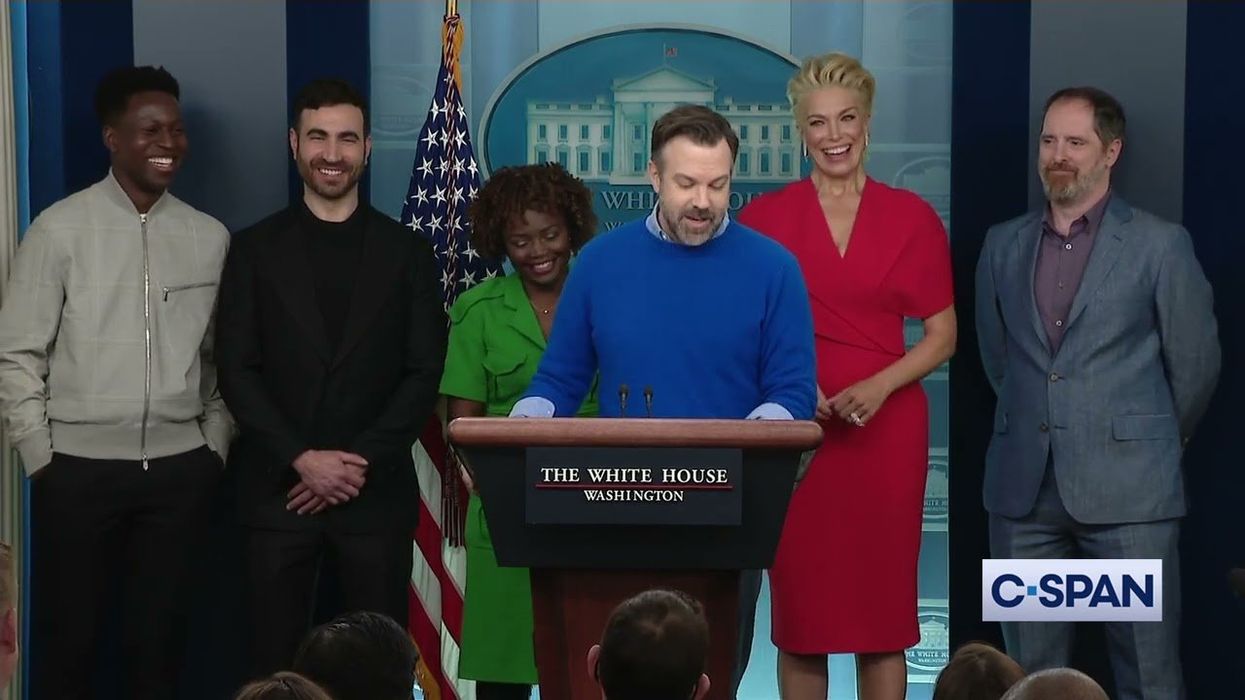Ted Lasso cast members Jason Sudeikis, Hannah Waddingham, Brett Goldstein, and Brendan Hunt joined the White House Press Briefing with Press Secretary Karine Jean-Pierre earlier this week to talk about the importance of mental health and encouraging people to check in with their friends, family, co-workers and others to help support and take care of each other.
Site Navigation
Search
Latest Stories
Start your day right!
Get latest updates and insights delivered to your inbox.
Top Stories
Latest news
Read More
The 50: Voices of a Nation Premieres on CAN-TV
Dec 18, 2025
Chicago, IL — As part of a partnership with The Fulcrum, CAN-TV will premiere The 50: Voices of a Nation, a groundbreaking hour-long special that takes viewers across the country to hear directly from communities about how life is unfolding under the Trump administration.
The program debuts on Thursday, December 18, at 7 p.m. CST on CAN-TV cable channel 19 (Chicago), and will also stream live at cantv.org and on the CAN TV+ app.
50 VOICES OF A NATION - Airs December 18th @7PM youtu.be
Hosted by Hugo Balta, Executive Editor of The Fulcrum and Publisher of the Latino News Network, The 50 is part of a four-year initiative to visit every state during the Trump presidency. The series asks: What drove voters to the ballot box in 2024, and how is the administration responding to their hopes, fears, and demands?
“This special is more than a broadcast—it’s a journey into the heart of America," said Balta. "By listening to communities from coast to coast, we uncover how democracy is lived every day: through resilience, through struggle, and through the voices that demand to be heard."
 Shannon Gormley, Rhode Island Public Schools
Shannon Gormley, Rhode Island Public Schools
The first eleven episodes already published by The Fulcrum showcase the diversity of challenges and resilience across America. In Rhode Island, families highlight the strain on education and social services. Shannon Gormley, a teacher in Rhode Island Public Schools, is concerned. "Nervous. My students come to me and say, 'Miss, are we still going to be able to have free lunch?' I think about our students who are in special education, and how the Department of Ed really helps our students in terms of individual education plans. So, for me, I guess the word would be nervous, worry."
 Les Sinclair, Blue Ridge Area Food Bank
Les Sinclair, Blue Ridge Area Food Bank
Virginia spotlights grassroots efforts to fight hunger. “Every month, we are seeing about 175,000 to 200,000 guest visits,” explains Les Sinclair, Marketing and Public Relations Manager at the Blue Ridge Area Food Bank. “If these folks were to stand shoulder to shoulder, they would form a line 41 miles long. The need for food assistance in our region is tremendous.”
 Elena Casillas Hoffman, Iowa MMJ
Elena Casillas Hoffman, Iowa MMJ
In Iowa, Latino-majority communities grapple with immigration crackdowns while organizing for civic power. "The reality is that ICE is in Iowa, but the tactics that they're using, the level which they're in our community, the fear that they have, the weaponized fear that they are able to utilize...it's all things that we are continuing to work with our communities right now," said Elena Casillas Hoffman, Communication Specialists with Iowa MMJ.
 Mayor Lynne Robinson, Bellevue, Washington
Mayor Lynne Robinson, Bellevue, Washington
Washington State examines how civic leaders balance infrastructure needs with environmental stewardship. We have all these lists of things we'd like to get done if we could, and pulling everybody together so that we can work together and get it done. We're trying to undo some of the things we did wrong when we didn't understand," said Bellevue's Mayor Lynne Robinson.
 Darrious Hilmon, Executive Director, CAN-TV
Darrious Hilmon, Executive Director, CAN-TV
In Illinois, CAN-TV was featured on how the network empowers residents to create and broadcast their own content, promoting local democracy and giving marginalized communities a voice. "Submit a program! We want your voice out there," said CAN-TV Executive Director Darrious Hilmon.
Hilmon emphasized the importance of this collaboration: “CAN TV is thrilled to continue its partnership with The Fulcrum with this special on-air presentation of 50 Voices. Taking an unflinching look at the motivations of voters in the last election is both illuminating and critical to how we collectively move forward.”
Other episodes explore rural towns confronting deportation raids, cities reimagining public safety, and immigrant workers in Iowa organizing against hardline policies.
By amplifying grassroots movements, immigrant voices, and civic organizations, The 50: Voices of a Nation offers viewers a rare chance to see democracy in action—one story, one state, one voice at a time.
Keep ReadingShow less
Recommended

The Tucson baseball team playing against the Águilas de Mexicali in the border city of Mexicali. Photo courtesy of the Tucson baseball team
A Baseball Team Caught Between Two Countries — a Visa Shift and a Shutdown
Dec 18, 2025
NOGALES, SONORA, MEXICO — What was meant to be a historic first for America’s pastime — a Mexican Pacific League baseball franchise anchored north of the border — has become a bureaucratic curveball.
The newly relocated Tucson, Arizona, baseball team — formerly the Mayos de Navojoa from Sonora, Mexico — has yet to fulfill a long-held dream shared by fans on both sides of the border: bringing professional Mexican winter baseball to U.S. soil.
A shift in U.S. State Department visa requirements for foreign players has forced the team to open its season on the wrong side of the border.
Rather than playing its “home” games in Tucson, the team kicked off the season in Hermosillo, Sonora. Meanwhile, Tucson’s venerable Kino Veterans Memorial Stadium remains without a tenant. In recent weeks, the team has been unable to host either the Yaquis from Ciudad Obregón or the Tomateros de Culiacán.
“We’re on a journey of playing as the home team while away,” Esteban Haro, the team’s sports manager, told El Imparcial, a Sonora-based regional newspaper.
What was billed as a cross-border experiment in baseball diplomacy — and a triumphant debut — has instead turned into an extended road trip for the Mexican Pacific League’s first U.S.-based franchise. Borderland fans from southern Arizona to northern Sonora are growing frustrated as the saga becomes a lesson in how geopolitics and bureaucracy can sap the joy from a sport.
“They are in the same situation, maybe even worse”, said Jesús Enrique Chiquete Cruz, a former Mexican professional baseball player, reflecting the anger many former Navojoa fans feel after the owners of the franchise decided to abandon the city and take their team north of the border.
The Mayos’ relocation — brought on by declining attendance, an aging stadium, and a drop in sponsorships since the COVID-19 pandemic — was supposed to mark a milestone for the Mexican Pacific League.

The Santa Catalina Mountains rise behind the scoreboard at Kino Veterans Memorial Stadium in Tucson, Arizona. Photo courtesy of Kino Sports Complex
The Mexican league, which has added the name Arco for sponsorship reasons, has long been a showcase for U.S. teams’ prospects and future stars.
Some U.S. Major League players spend their offseason playing in the Mexican league to stay active, refine their skills, or maintain a competitive rhythm. Other U.S. players recovering from injuries or looking for extra playing time often join Pacific League teams to stay sharp before spring training.
Seattle Mariners outfielder Randy Arozarena and Toronto Blue Jays catcher Alejandro Kirk — both of whom took part in this year’s American League pennant series won by the Jays — once played for Mexican teams.
That tradition has helped make the league one of the highest-caliber tournaments in winter baseball.
Founded in 1950, the Mayos de Navojoa were a cornerstone of baseball in southern Sonora, playing at the Manuel “Ciclón” Echeverría Stadium and winning two league championships, most recently in the 1999–2000 season. Generations of fans packed the stands to watch local heroes and future U.S. Major League players take the field.
But in recent years, the franchise struggled to stay afloat.
“It was no longer sustainable,” team owner Víctor Cuevas said at a press conference in May announcing the team’s relocation plans. Cuevas said his team instead would move to Tucson in search of a larger market and a modern stadium. It would create a symbolic bridge between Mexican and American baseball cultures.
The move promised a sports renaissance for Tucson.
The city has been without a Triple-A team since 2013, when the Tucson Padres, an affiliate of the San Diego Padres, moved to Texas, to become the El Paso Chihuahuas. Tucson officials hailed the Mayos’ arrival as a win-win.

The Tucson baseball team after a game against the Algodoneros de Guasave. Photo courtesy of the Tucson baseball team
Kino Stadium would finally have a tenant again. The Mexican league would extend its reach to Latino fans in the United States and attract supporters from northern Sonora.
Anticipation built on both sides of the border. The team’s debut in mid-October was to be more than a ball game — it was billed as a celebration of binational identity, uniting two baseball-loving cultures.
But just days before the opener, the plans unraveled.
We “officially announce that the start of the Tucson Baseball Team's season at Kino Veterans Memorial Stadium will be postponed until further notice,” said the Mexican Pacific League in a statement, “due to ongoing legal processes with U.S. authorities.”
Those authorities informed the team that most players and coaching staff could not enter the country under their current B-1/B-2 visas, typically intended for tourism or short business visits. Because the franchise had permanently relocated its operations to the United States, players now required visas specifically made for professional athletes.
That bureaucratic shift effectively benched the entire roster. The recent government shutdown halted many immigration processes, and new visa approvals are delayed.
As a result, the Tucson team played its opening series against the Naranjeros de Hermosillo on the rival’s home field in mid-October — an awkward start to what was supposed to be a historic season, and one that has set the tone ever since.
The visa situation has rippled far beyond baseball.
Immigration delays have disrupted several binational sports and cultural exchanges, from youth soccer tournaments to touring musicians. Programs like Sports Visitor and Sports Envoy — designed to foster cross-border athletic collaboration — have faced postponements due to visa processing backlogs, according to the U.S. embassy in Mexico City.
For the Mexican Pacific League, the Tucson project was a key part of its international expansion strategy.
“This is a necessary evolution,” league president Salvador Escobar said in a statement. “International expansion comes with challenges, but we are committed to overcoming them.”

The Tucson baseball team during batting practice in Ciudad Obregón, Sonora. They were forced to play as t
he home team because most of their roster lacked U.S. visas. Photo courtesy of the Tucson baseball team
Local officials in Tucson have expressed disappointment but say they remain hopeful. Both the team and the league are working tirelessly to solve the problem.
The “Mexican Pacific League and the Tucson Baseball Team will continue working together to expedite the … process and continue with our internationalization efforts for the benefit of both organizations and our fans,” league officials said in its statement. “We sincerely appreciate the understanding, support, and patience of the Tucson community, sponsors, and fans of the League.”
Meanwhile, the team’s departure still stings many in Navojoa. Longtime fans describe it as losing part of the city’s soul, but they recognize the benefits the move would bring to the team’s roster.
“You’re over there in the land of opportunity, and for many Mexican players, that could be their window” of opportunity, added Chiquete Cruz, who also works as a sports promoter. “Here you must do the work, then go through a Caribbean series, and stay in the spotlight to see if you’re a candidate or not. Over there, you’re already where everyone wants to be.”
Still, on both sides of the border, hope endures for next season. For now, as the season ends this month, the team moved its home games to Mexicali in the Mexican state of Baja California.
But when the long-awaited moment finally arrives, and the umpire calls “Play Ball” under the Arizona lights, it will mean more than the start of a game. It will mark the beginning of a new chapter in North American baseball — one written in two languages and waiting to be played.
A Baseball Team Caught Between Two Countries — a Visa Shift and a Shutdown was originally published by Palabra. and is republished with permission.
Keep ReadingShow less

Record tariff revenues mask a deepening U.S. fiscal crisis as deficits, debt, and interest costs soar, raising alarms about economic stability and governance.
Getty Images, Andriy Onufriyenko
America’s Tariff Mirage and the Coming Debt Reckoning
Dec 17, 2025
The latest fiscal disclosures from the US Treasury offer a stark reality check for a country that continues to see itself as the global lodestar of economic stability. Tariffs, once an auxiliary tool of industrial policy or bargaining chip in trade negotiations, have quietly morphed into the financial backbone of the Trump administration’s economic experiment. October’s revenue haul - an unprecedented thirty-four point two billion dollars, up more than threefold from a year earlier - has been heralded by the White House as vindication. It is, according to President Trump, not merely proof that tariffs are “working,” but a testament to a new era of American prosperity robust enough to fund direct cash transfers to households. A two-thousand-dollar bonus, he insists, is just the beginning.
The president has taken to social media to cast opponents of this approach as out-of-touch elites, blind to a transformed landscape in which the United States is, in his words, “the richest and most respected country in the world.” Record stock prices, swollen retirement accounts, and subdued inflation are deployed to sustain an alluring political narrative: that tariffs are no longer punitive, but emancipatory - a fiscal engine capable of generating national renewal.
Scratch beneath the slogans, however, and the numbers point to a far more sobering outcome. Even with this historic spike in tariff receipts, the federal government still ran a deficit of two hundred and eighty-four billion dollars in October alone - the highest opening-month deficit in US fiscal history. Calendar quirks softened the figure on paper, yet the adjusted deficit still stood at one hundred and eighty billion dollars. No serious policymaker can describe that as anything other than alarming.
International institutions are equally unconvinced. The International Monetary Fund cautions that far from reversing America’s fiscal descent, the administration’s strategy could accelerate it. By 2030, US public debt is projected to climb to one hundred and forty-three percent of GDP - fifteen points higher than previous estimates. The drivers are not mysteries: outsized spending promises dressed up as populism, from infrastructure to defense upgrades to cash giveaways, with no credible revenue path to support them.
The cost of carrying this burden is no longer an abstract line on a Treasury report. In October alone, the United States paid one hundred and four billion dollars in interest—the highest ever recorded for that month. Over the past year, interest payments totaled one trillion two hundred and forty billion dollars, a staggering quarter of all federal tax revenue. Each dollar spent on servicing past decisions is a dollar that cannot be used for housing, schools, transportation, or healthcare. Washington is mortgaging tomorrow to pay for yesterday.
Tariffs themselves, the supposed cure, are becoming part of the disease. They operate in practice as a stealth consumption tax. Import prices have climbed, eroding real wages by roughly two point three percent—a bitter irony for the manufacturing workers who were promised restoration. Business margins have tightened, investment has slowed, and the tax base has shrunk. What was sold as a patriotic duty increasingly resembles a self-defeating spiral.
The political fallout is already visible. On November 25, several states sued the federal government, demanding restitution of more than three billion dollars previously earmarked for homelessness programs. Local officials warn that the cuts could deprive one hundred and seventy thousand Americans of housing assistance. It is an extraordinary moment: Washington proclaims a new era of tariff-funded grandeur while the states struggle with acute social crises.
These contradictions ripple far beyond domestic politics. The world’s financial architecture rests on confidence in US Treasury securities. That confidence is not inexhaustible. A sustained increase in borrowing costs could force Washington into painful austerity or curtail its geopolitical footprint - outcomes that would reshape global power dynamics in ways few Americans are prepared to confront.
Some optimists point to Japan, a wealthy nation that coexists with towering debt. The analogy is precarious. Japan’s liabilities are owned overwhelmingly by its own citizens. America relies on foreign creditors and the intangible asset of global trust. That trust endures only so long as the world believes the United States can, and will, rein in its liabilities.
The administration insists it is charting a revolution in economic philosophy. Yet revolutions are judged not by their slogans, but by the legacies they leave. Tariffs can fund political theatre, but they cannot substitute for a coherent fiscal doctrine. Deficits can be rationalized for a time, but not forever. Illusions can animate a movement, but they eventually collide with arithmetic.
The United States remains a country of immense capacity - capable of balancing ambition with discipline, prosperity with prudence. What it lacks is consensus. A nation that cannot agree on what government should do cannot agree on how to fund it. The current model of financing popularity through border taxes and ballooning deficits is not a strategy. It is a gamble with stakes that extend far beyond one election cycle.
This absence of consensus is not merely an economic failure; it is a profound crisis of governance and civic capacity. For decades, Americans have been deliberately shielded from the true cost of their government - borrowing trillions to finance tax cuts, wars, and entitlements without ever asking the public to pay the bill in real time. Safe congressional districts drawn through extreme gerrymandering have empowered the most ideological voices in both parties, turning compromise into betrayal and rewarding politicians who refuse to level with voters about trade-offs. Primary voters and polarized media ecosystems further punish any leader who dares acknowledge that every new benefit or tax cut must eventually be paid for. Until citizens themselves demand - and reward - politicians willing to make the hard choices, no amount of tariff revenue or budgetary gimmicks will arrest the slide. The fiscal crisis will not be solved in Washington alone; it must first be confronted in the mirror of public opinion.
The world expects leadership from Washington, not improvisation masquerading as innovation. The clock has not yet struck midnight, but it is no longer early evening. Debt, like time, accumulates quietly until it defines a nation’s choices. The question before America is no longer whether it can afford to change course. It is whether it can afford not to.
Imran Khalid is a physician, geostrategic analyst, and freelance writer.
Keep ReadingShow less

New York Mayor-Elect Zohran Mamdani speaks during a press conference on December 12, 2025, in New York City.
Photo by Michael M. Santiago/Getty Images
Mamdani’s Choice
Dec 17, 2025
I obviously can’t say with certainty what kind of private advice President Barack Obama, AOC, Bernie Sanders, and other DNC establishment consultants may have given New York City Mayor-elect Zohran Mamdani during the campaign or in the days after his victory, but I can make an educated guess.
My guess is that they counseled him to subside a bit with the tumult, recede in the background, quietly focus heads-down on delivering something “concrete” (and do it fast) by working with the people who hold power, including the governor, his two senators, the congressional delegation, and especially Minority Leader Hakeem Jeffries.
And so, not even one month into the transition, and we’re already seeing the imprints of that advice.
Pointed case in point: Chi Ossé, a young Brooklyn councilmember known for his outspoken progressive stance and willingness to challenge the Democratic establishment, inspired and energized by Mamdani’s win, has emerged as a potential insurgent rival to Hakeem Jeffries in the coming 2026 Democratic primaries. Ossé, like Mamdani, is a Democratic Socialist, and just like Mamdani was back in the fall of 2024, he is a very long shot as things stand. Flush with his landslide victory, one would have thought that Mamdani would declare him his first official protege and put all his weight behind supporting him.
But according to both Politico and The Daily News, instead of siding with his fellow Democratic Socialist, Mamdani has “spoken to the Brooklyn lawmaker more than once to talk him out of running and has distanced himself from the effort” to mount that challenge. And when pressed about whether he supports Ossé, Mamdani has retreated to a tightly controlled line: “I ran to deliver on an affordability agenda, and that agenda continues to be my focus.” And behind closed doors, as reported by the Daily News, he has pleaded: “I believe that endorsing [Osse] makes it […] more difficult to deliver on the life-changing policies that more than 1 million New Yorkers voted for just two weeks ago.”
The establishment’s handlers could not have drafted a more compliant sentence.
The thing is that this is exactly the wrong thing to do at this moment, when the embers of victory are still glowing.
If Mamdani wants to deliver on his promises to his constituents, he needs to take seriously the basic reality that is about to confront him. In order to govern, he needs to focus on building a governing power base strong enough to withstand establishment roadblock obstructions that are bound to be thrown on his path.
Doing this requires keeping his base united and energised, and the battle he has been waging is going well, while flexing his political muscle by helping elect and establish real allies and fellow mission travellers rather than count on domesticated figures who call their caution “strategic” but have mastered the art of protecting the very status quo that sustains their careers. In other words, Mamdani needs people who share his worldview, not those who, as Ossé rightly puts it, “have failed to deliver a vision that we can all believe in.”
And that means backing, nurturing, and multiplying insurgents, not abandoning them in the name of staying on good terms with the very establishment that never wanted him elected in the first place and does not wish him well.
Now imagine if Mamdani were not to shy away from Ossé’s challenge to Jeffries but instead embraced it as part of his governing strategy.
Imagine him helping build a campaign for Ossé that dethrones Jeffries or even comes close to unseating him. Either outcome would shift the balance of power, making it Jeffries who must stay in Mamdani’s good graces rather than the other way around. If Jeffries loses, he becomes a moot issue (and even better, a cautionary to the establishment keeping their distance from the insurgency), replaced by a congressional ally, making Mamdani the de facto leader of the party, well positioned to run for a congressional seat or the governorship in 2030. And if Jeffries wins by a narrow margin, he would still have every incentive to keep Mamdani close and perhaps even work to help re-elect him as mayor in 2029 or governor in 2030.
Beyond such calculations, if Mamdani were to signal early on and unmistakably that his mission is a principled one, that he will not be turned into a Cuomo-stripe horse trader, that he would rather fail while fighting Deep Gotham on behalf of his constituents and upholding the principles they elected him to defend than succeed by keeping the machinery of business as usual running, he would force the fundamental realignment he needs to advance the decisions the establishment will do everything in its power to resist. He would show that his election was not a ceremonial victory but the opening salvo of a project aimed at fundamentally changing the balance of power.
The worst thing that Mamdani could do now is behave as though the establishment’s cooperation is necessary for him to govern. It is not. The establishment’s obstruction is already guaranteed. What matters is whether he prepares the public to recognize that obstruction for what it is and ensures that they remain behind him, loud, engaged, and visible. Because his power comes from the people, not from political operatives who are intent on draining that power by urging him to cooperate with them, only for him to end up with neither real results nor a movement worthy of the name.
This is the moment for Mamdani to paint a clear picture: That the biggest obstacles to his agenda will not come from Republicans but from within his own party; that those obstacles can only be overcome by a movement strong enough to make obstruction politically dangerous; and that such a movement can only grow if he backs leaders who share his commitments, not those who have been absorbed and neutralized by the system.
If Mamdani imagines that he can deliver a couple of marquee promises while leaving the rest of the machinery intact, then he will prove to have been as naïve as his opponents accused him of being. The establishment is not afraid that he will govern modestly. They are afraid that he will govern boldly. They do not fear a mayor who passes a few programs here and there. What they fear is a bold mayor who inspires bold successors. Because, to state the obvious, their goal is not to help him succeed. Their goal is to ensure that he becomes a cautionary tale and a lesson to all would-be insurgents that the path to power ends in co-optation.
Keep in mind this tidbit, which may come as a surprise or even a shock if you were not aware: Just like New York Senator Chuck Schumer, Barack Obama never officially endorsed Zohran Mamdani, even when it was clear that he was going to win. Yes, Obama can claim that he doesn’t endorse local elections. But then again he did endorse Karen Bass in Los Angeles for her Mayoral race in 2022. So what’s the difference? The difference is that she is a dyed-in-the-wool establishment Democrat with a decade in Congress and a term as chair of the Congressional Black Caucus. Mamdani is not. Mamdani is not part of the Big Establishment Family.
And so what does this tell us?
This tells us that the only way to defeat the deeply embedded logic of an establishment that thinks that it is entitled to play chess and strategic pursuit with the will of the people is to fight not as an isolated figure but as the tip of a spear. Let them try to obstruct him, not alone, but in full view, and against a mobilized, expanding movement, with the people visibly behind him, continually in the game, engaged, with their ranks swelling as the battle for their dignity rages on and as the ugly mask of a shaken establishment falls time and again with every confrontation. Let his opponents fight not just him but a generation rising behind him. That is how real power is built against an establishment that will not relinquish it without a bitter fight.Ahmed Bouzid is the co-founder of The True Representation Movement.
Keep ReadingShow less
Load More

















